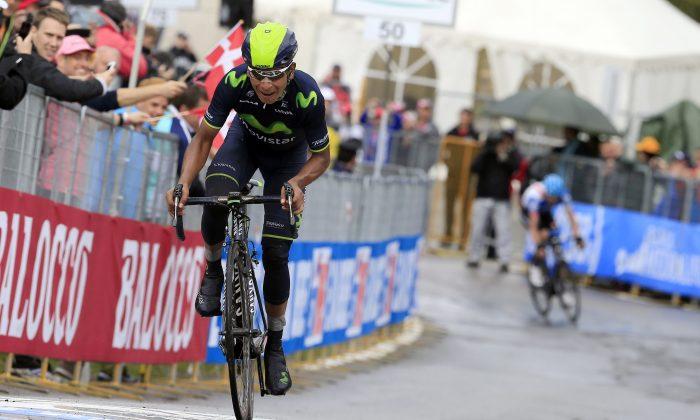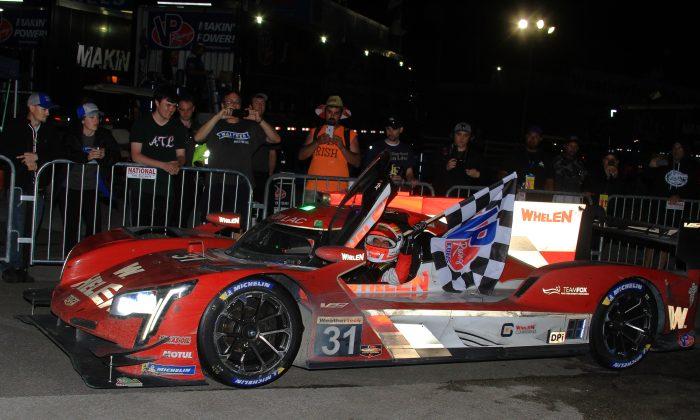Movistar’s climbing ace Nairo Quintana used his skill to perfection in winning Giro d'Italia Stage 16 and taking over the race lead.
The 24-year-old Quintana attacked the peloton with 40 km and one Cat 1 summit finish left in the 139-km stage, dropping race leader Rigoberto Uran and everybody else on the 23-km final climb.
The slightly-built Colombian seemed totally at ease even on the steepest sections of the climb, which reached 14 percent gradient; he looked equally comfortable riding in or out of the saddle, and never seemed to be laboring.
Despite having been sick with an infection and on antibiotics since the start of the race, the Movistar team leader had no problem pedaling up any of the day’s difficult climbs, the Cat 1Passo Gavia, the Hors Categorie Stelvio, or the Cat 1 ascent to the finish line at Val Martello.
“This gives me confidence and confirms that I can achieve great things in the present and in the future,” Quintana told Cyclingnews.com “I dedicate it to my team. I owe them all this victory.”
Even freezing weather, rain, and snow on the Stelvio didn’t seem to faze the young Colombian, and when the weather cleared approaching the final climb he proved he was the best in the mountains—on that day, at least.
The descent from Stelvio was so treacherous there was talk that the organizers might neutralize the race until the bottom. When the snow turned to rain, the idea was dropped, though dense fog and cold, wet roads made the descent a test for all riders.
Some still attacked. Sky’s Dario Cataldo attacked halfway up the climb and stayed away most of the way down. Quintana led a group of five after Cataldo, attacking on the descent and holding a small advantage onto the climb, where his climbing skills made the difference.
Quintana erased a 2:40 deficit to fellow Colombian Uran and added a 1:41 lead on the Omega Pharma-Quick-Step rider, taking the leader’s jersey in a Grand Tour for the first time. With two brutal mountain stages and an uphill time trial on tap, it is entirely probable that this race will be Quintana’s first Grand Tour General Classification victory.
Uran Clings to Second, Evans Vulnerable in Third
Ryder Hesjedal crossed the line eight seconds behind Quintana. The Garmin-Sharp GC hopeful was part of the five-rider attack Quintana led away 40 km out, and with Europcar’s Pierre Rolland followed the Movistar rider when he attacked again a quarter of thee way up the final climb.
Hesjedal couldn’t stay with Quintana, but he refused to stop trying; he was dropped repeatedly, and repeatedly clawed his way back. His brave performance advanced the 33-year-old Canadian form 11th to ninth in GC, from 6:44 down to 4:16.
Pierre Roland held on to finish third, advancing from eighth to fourth in GC. Rigoberto Uran, apparently enervated by the cold, found new strength in the closing kilometers, coming home ninth and gaining 37 seconds on BMC’s Cadel Evans, who also had to fight desperately just to finish tenth.
“In the final, I started cramping,” Evans told Cyclingnews. “I was limping on one leg all the way home. It is a pity. Normally I am reasonably good in these extreme conditions. But when I can’t see the road, I can’t descend down it. When I have to pedal with one leg, I can’t go uphill. So it was really a day of conservation and survival.”
Uran, who topped GC at the start of the stage, is still in decent shape: at 1:41 down, he has 1:20 on Evans. Evans will have to be on perfect form for every stage from here on out to stay ahead of Pierre Rolland who is five seconds behind him, or Best Young Rider Rafal Majka of Tinkoff-Saxo, another three seconds back.
Astana’s Fabio Aru, who won Stage 15, is 3:34 off the lead and well within podium range, as is Ag2R’s Domenico Pozzovivo at 3:39 and Belkin’s Wilco Kelderman at 4:06. Even Hesjedal at 4:16 has a decent shot at a podium finish if he can pull out a couple more rides like this one.
The Agonizing Final Week
At 204 km from Sarnonico to Vittorio Venetto and containing three Cat 4 climbs, Stage 17 is long and lumpy and a beautiful set for a battle between the sprinters’ teams and the smaller teams which will try to win from a breakaway. The GC riders will use the stage as a rest day.
They will need it. Stage 18, 171 km from Belluno to Rifugo Panarotta, ends in yet another Cat 1 summit finish after the Cat 1 Passo San Pellegrino and the Cat 2 Passo del Redebus.
Stage 19 is a 26.8 mountain time trial, 26.8 kilometers at an average gradient of eight percent, with maximum inclines of 14 percent. The steepest stuff comes two-thirds of the way through, with a few hundred meters respite before the last three km kick up sharply again. It is short, but this stage will be very, very tough. The potential for great disappointment is very high in this one.
Hard as these two stages may be, they seem s tame next to Stage 20, 167 km from Maniago to Monte Zoncolan.
Zoncolan
What kind of sadistic mind could conceive of a summit finish on the Zoncolan, one of the toughest climbs in all of cycling, is hard to imagine, but fans will be as grateful as the riders will be hateful—this climb, coming after the Cat 1 Passo del Pura and Cat 2 Sella Razo, will ruin riders’ hopes and dreams.
Zoncolan is only a ten-km climb—only half as long as those the riders faced in Stage 16. It is shorter, and it is steeper—about half of the climb averages over ten percent, and the final four kilometers are the steepest.
Consider the profile of the final three kilometers: 1000 meters at 12.6 percent, 100 meters at 18, then about 150 meters at 19 percent before dropping off a few degrees for the final hundred meters. The whole section averages over 13 percent, which would be deadly enough for a ten-k climb. Add to that the Cat and Cat 2 leading up to it, and the 19 days of riding leading up to those ....
There might not be any attacks on Zoncolan simply because every rider will be turned inside out just trying to reach the finish line. If there are any riders still with reasonable hopes of advancing in GC, expect to see superhuman efforts from those riders—particularly if riders ahead of them in GC start to crack.
Every climb up Zoncolan is epic, but a summit finish to close out a Grand Tour? Don’t miss this one.
|
Giro d'Italia Stage 16 | |||
|
rider |
team |
time |
1 | Nairo Quintana | Movistar | 4:42:35 |
2 | Ryder Hesjedal | Garmin Sharp | 0:00:08 |
3 | Pierre Rolland | Europcar | 0:01:13 |
4 | Wilco Kelderman | Belkin | 0:03:32 |
5 | Domenico Pozzovivo | AG2R | 0:03:37 |
6 | Fabio Aru | Astana | 0:03:40 |
7 | Rafal Majka | Tinkoff-Saxo | 0:04:08 |
8 | Sebastian Henao | Sky | 0:04:11 |
9 | Rigoberto Uran | Omega Pharma-Quick-Step |
|
10 | Cadel Evans | BMC | 0:04:48 |
|
General Classification after Stage 16 | |||
1 | Nairo Quintana | Movistar | 68:11:44 |
2 | Rigoberto Uran | Omega Pharma-Quick-Step | 0:01:41 |
3 | Cadel Evans | BMC | 0:03:21 |
4 | Pierre Rolland | Europcar | 0:03:26 |
5 | Rafal Majka | Tinkoff-Saxo | 0:03:28 |
6 | Fabio Aru | Astana | 0:03:34 |
7 | Domenico Pozzovivo | AG2R | 0:03:49 |
8 | Wilco Kelderman | Belkin | 0:04:06 |
9 | Ryder Hesjedal | Garmin Sharp | 0:04:16 |
10 | Robert Kiserlovski | Trek | 0:08:02 |





